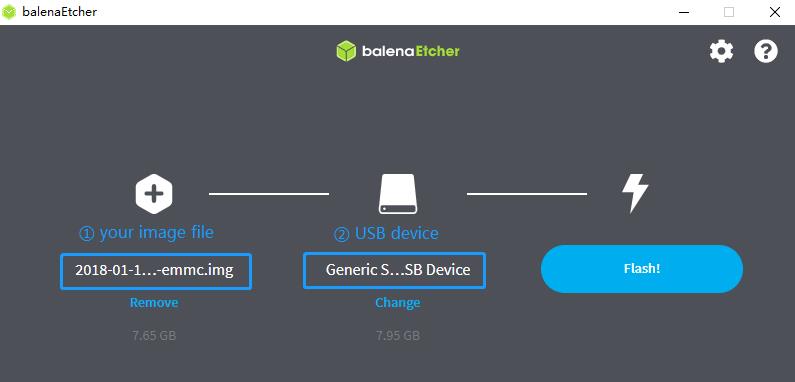
¶ Introduction
BananaPi BPI-CM6 adopts K1 core,Using multi-channel power management chip . Storage adopts LPDDR4X and eMMC. There are peripheral devices such as 2 lane M.2 KEY M,one USB2.0,one USB3.0,WIFI/BT, TF Card, HDMI TX, MIPI DSI, MIPI CSI, TYPE-C, 2xGBE, etc. Integrated, integrating a stable and scalable solution.
¶ Development
¶ Prepare
-
Prepare a TTL cable, a 12V PD power supply, USB cable, and a minimum of 8G TF card.
-
Please download the SD and EMMC images to be burned.
-
Please note that the image ending with "bianbu-k1-xxx.img.zip" is the SD card image, while the image ending with "bianbu-k1-xxx.zip" is the EMMC image. Please do not make the wrong selection when burning.
¶ Install Image to SDcard
| Please select the image ending in "bianbu-k1-xxx.img.zip" for Bianbu. Don’t choose the wrong one! |
Balena Etcher is an opensource GUI flash tool by Balena, Flash OS images to SDcard or USB drive.
-
Click on "Flash from file" to select image.
-
Click on "Select target" to select USB device.
-
Click on "Flash!" Start burning.

| Remember to connect to the HDMI screen when starting, and then create your own account. |
¶ Install Image to eMMC 1
| Please select the image ending in "bianbu-k1-xxx.zip" for Bianbu. Don’t choose the wrong one! |
Install driver software
-
Double click titantools_for_windows-latest to install. Linux grants executable permissions and can be run by opening titantools_for_Linux-latest without the need for installation.
-
It is installed on the computer’s C drive by default, and will require a certain amount of space for future use. So please ensure that the remaining available space is greater than 10G (Linux has a Home space greater than 10GB)
-
Allow this app from unknown publishers to make changes to your device. Then choose to always install this driver software.
-
If the driver installation is successful, it will prompt that the USB driver installation is successful.
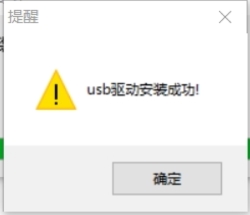
Visual software burn image to EMMC
-
Click Single Machine Burn (If you need to burn multiple devices simultaneously, click Multiple Machine Burn)
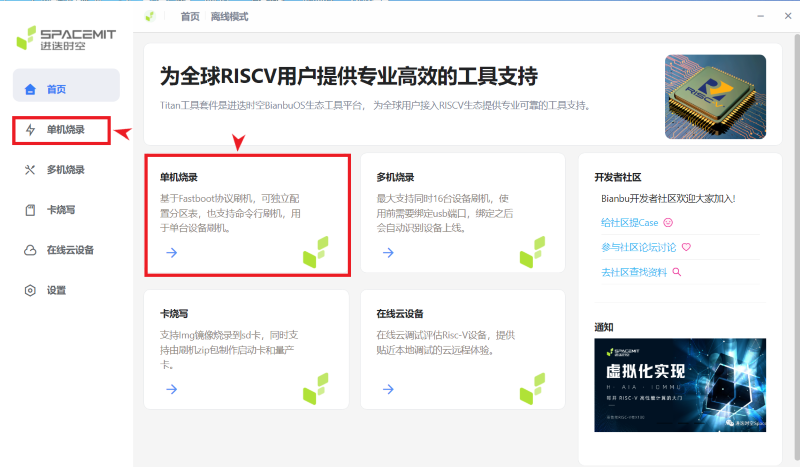
-
To put the device into flashing mode:
-
Method 1:
The device is not powered on. Press and hold the DOWNLOAAO (FEL) button, plug in the type-c, and then release the button. (If you are worried about insufficient USB power, you can first plug in the power, then release the button, and then plug in the USB cable) -
Method 2:
The device is powered on. Press and hold the DOWNLOAD (FEL) button, then press the Reset button, and then plug in the USB cable.
When connected to a USB HUB, there may be a "Fastboot device initialization failure". -


If the software recognition is successful, a "VID:PID=" display will appear. If there are multiple devices, please select the device you want to burn.
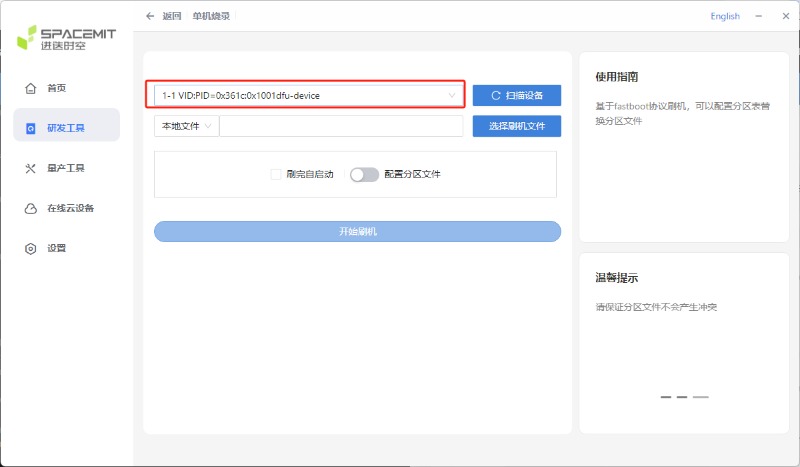
-
Select the flash file, the software will decompress it, please be patient and wait for a while.
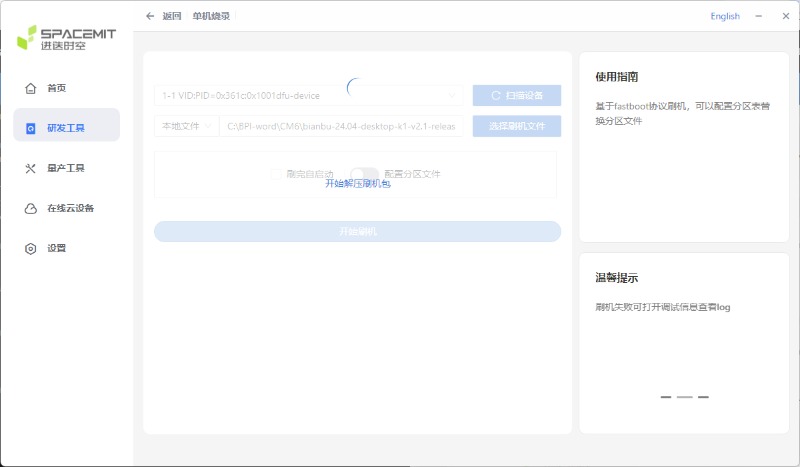
-
Click to start flashing.
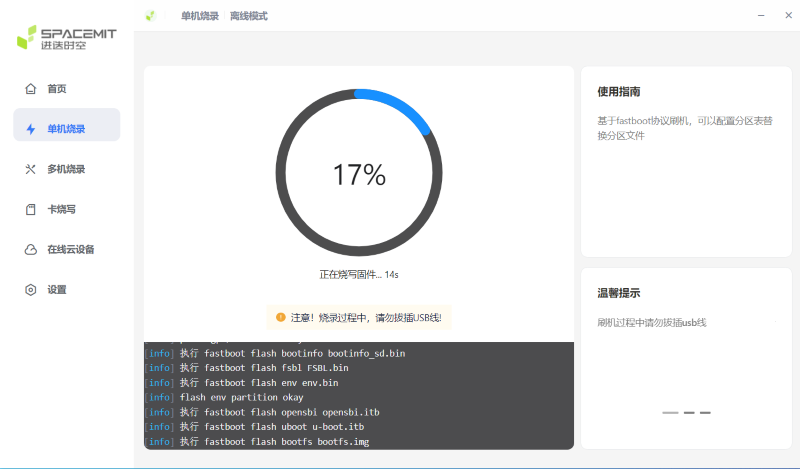
-
Burn completed, power on again.
Non-visual software burns image to EMMC
This is another way of burning.Use the titanflasher tool,then put this flashserver.exe file under the EMMC image file you want to burn.
Run it on your computer as shown in the following screenshot:
When the system recognizes the device(VID:=PID=XXX), select "1" item to brush the machine.
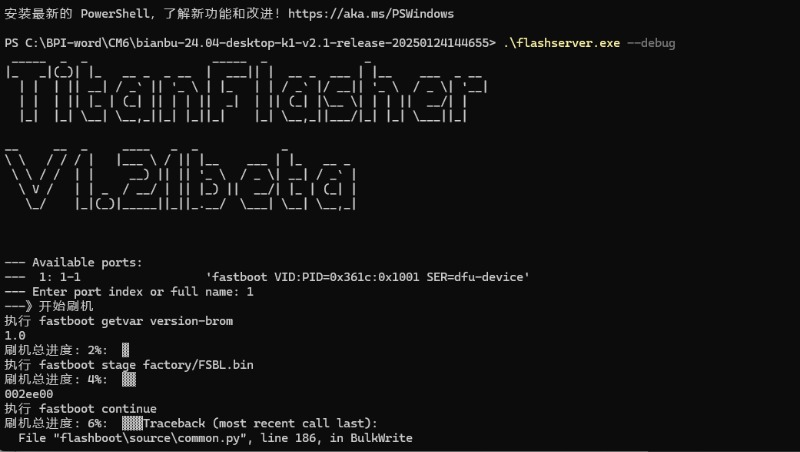
¶ Install Image to eMMC 2
| The Armbian image currently only supports SD card startup. |
| In addition to using titantools, you can also use the dd command to burn the image to emmc. |
Take bianbu-24.04-desktop-k1-v2.1-release-20250124144655.img. Unzip the "bianbu-k1-xxx.img.zip" to the USB drive, and then copy the "fsbl.bin" and "bootinfo_emmc.bin" in "bianbu-k1-xxx.zip" to copy it into the USB drive.
-
Firstly, insert the SD card that has been burned into the image into F3 and power it on to start.
-
Insert the copied USB drive into F3.
-
After startup, use the "lsblk" command to view.
pi@k1:~$ lsblk NAME MAJ:MIN RM SIZE RO TYPE MOUNTPOINTS sda 8:0 1 14.8G 0 disk └─sda1 8:1 1 14.8G 0 part mmcblk0 179:8 0 14.8G 0 disk ├─mmcblk0p1 179:9 0 256K 0 part ├─mmcblk0p2 179:10 0 128K 0 part ├─mmcblk0p3 179:11 0 384K 0 part ├─mmcblk0p4 179:12 0 2M 0 part ├─mmcblk0p5 179:13 0 256M 0 part └─mmcblk0p6 179:14 0 8G 0 part / mmcblk2 179:8 0 14.6G 0 disk"sda1" refers to a USB drive, "mmcblk0" refers to an SD card, and "mmcblk2" refers to an EMMC.
-
Mount the USB drive to mnt first.
sudo mount /dev/sda1 /mnt cd /mnt -
Then use the dd command to burn the image to emmc
sudo dd if=bianbu-24.04-desktop-k1-v2.1-release-20250124144655.img of=/dev/mmcblk2 bs=10MIf you enter the lsblk command, you can see BOOT. You can go directly to step 9. -
Next, update the boot0 partition of EMMC. However, some image boot partitions are hidden by default, so you need to modify the cmdline. Mount bootfs:
sudo mount /dev/mmcblk0p5 /boot sudo nano /boot/env_k1-x.txtFind Commonargs and add "recovery=1" at the end.
commonargs=setenv bootargs earlycon=${earlycon} earlyprintk console=tty1 console=${console} ${loglevel} clk_ignore_unused rdinit=${init} recovery=1Save and restart.
sudo reboot -
After the restart is completed, you can see the BOOT partition using the lsblk command.
pi@k1:~$ lsblk NAME MAJ:MIN RM SIZE RO TYPE MOUNTPOINTS sda 8:0 1 14.8G 0 disk └─sda1 8:1 1 14.8G 0 part mmcblk0 179:0 0 14.8G 0 disk ├─mmcblk0p1 179:1 0 256K 0 part ├─mmcblk0p2 179:2 0 128K 0 part ├─mmcblk0p3 179:3 0 384K 0 part ├─mmcblk0p4 179:4 0 2M 0 part ├─mmcblk0p5 179:5 0 256M 0 part └─mmcblk0p6 179:6 0 8G 0 part / mmcblk2 179:8 0 14.6G 0 disk ├─mmcblk2p1 179:9 0 256K 0 part ├─mmcblk2p2 179:10 0 64K 0 part ├─mmcblk2p3 179:11 0 1M 0 part ├─mmcblk2p4 179:12 0 2M 0 part ├─mmcblk2p5 179:13 0 256M 0 part └─mmcblk2p6 179:14 0 2G 0 part mmcblk2boot0 179:16 0 4M 1 disk mmcblk2boot1 179:24 0 4M 1 disk -
Mount a USB drive
sudo mount /dev/sda1 /mnt cd /mnt -
Execute the following command:
echo 0 | sudo tee /sys/block/mmcblk2boot0/force_ro sudo dd if=bootinfo_emmc.bin of=/dev/mmcblk2boot0 sudo dd if=FSBL.bin of=/dev/mmcblk2boot0 seek=512 bs=1 sync -
After waiting for the burning to complete, disconnect the power and remove the SD card and USB drive. Power on again to start from the EMMC.
¶ Other Development
¶ WiFi/BT
You have two ways to setup WiFi
-
Use UI interface to setup WiFi
-
Use commands to setup WiFi
sudo nmcli dev sudo nmcli r wifi on sudo nmcli dev wifi sudo nmcli dev wifi connect "SSID" password "PASSWORD" ifname wlan0
You have two ways to setup BT
-
Use UI interface to setup BT
-
Use commands to setup BT
hciconfig sudo bluetoothctl power on //Open the Bluetooth network card discoverable on //Set the controller to discoverable pairable on //Set the controller to be pairable scan on //Scan MAC addresses of other Bluetooth devices scan off //Close scanning agent on //Open the agent for connecting to other Bluetooth devices pair <MAC address> //Pairing Bluetooth devices disconnect <MAC address> //Disconnect remove <MAC address> //Unpairing connect <MAC address> //Connecting a Bluetooth device exit
¶ RTC
A button battery with a 1mm PIN was used to plug into the RTC battery slot to power the RTC.
root@bananapicm6io:~# date -s 2028-08-08
2028年 08月 08日 星期二 00:00:00 CST
root@bananapicm6io:~#
root@bananapicm6io:~# hwclock -w
root@bananapicm6io:~#
root@bananapicm6io:~#
root@bananapicm6io:~# date -s 2021-01-01
2021年 01月 01日 星期五 00:00:00 CST
root@bananapicm6io:~#
root@bananapicm6io:~# hwclock -r | grep "2028-08-08" | wc -l
1
root@bananapicm6io:~# hwclock
2028-08-08 00:00:54.602891+08:00
root@bananapicm6io:~# date
2021年 01月 01日 星期五 00:01:04 CSTThe RTC clock has been set successfully.
¶ NVMe SSD
| There are two M.2KEY M interfaces on the board, and you can choose one of them to use. |
Please insert one M.2 KeyM SSD into any one KeyM slot.
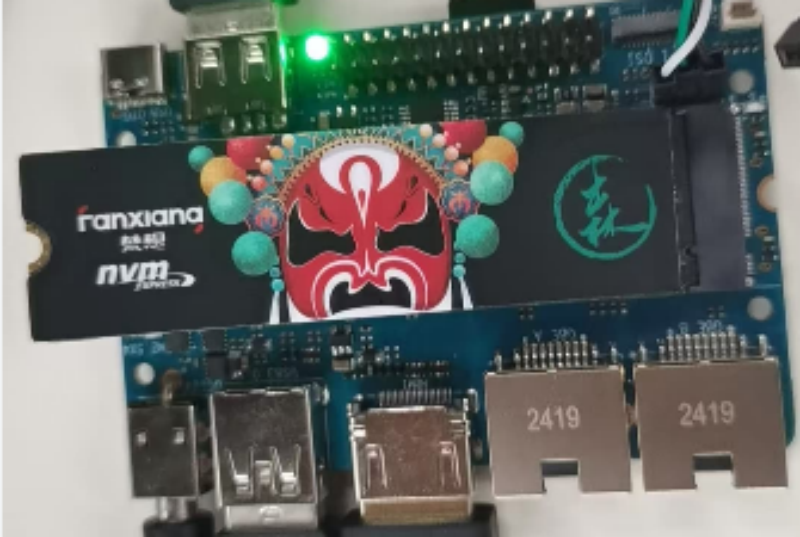
Then use the command to query:
The memory size of the device and nvme can be queried by lspci and lsblk.
pi@bananapicm6io:~$ lspci
0001:00:00.0 PCI bridge: Device 201f:0001 (rev 01)
0001:01:00.0 Non-Volatile memory controller: MAXIO Technology (Hangzhou) Ltd. NVMe SSD Controller MAP1202 (DRAM-less) (rev 01)
0002:00:00.0 PCI bridge: Device 201f:0001 (rev 01)
pi@bananapicm6io:~$ lsblk
NAME MAJ:MIN RM SIZE RO TYPE MOUNTPOINTS
mmcblk2 179:0 0 14.6G 0 disk
├─mmcblk2p1 179:1 0 256K 0 part
├─mmcblk2p2 179:2 0 64K 0 part
├─mmcblk2p3 179:3 0 1M 0 part
├─mmcblk2p4 179:4 0 2M 0 part
├─mmcblk2p5 179:5 0 256M 0 part
└─mmcblk2p6 179:6 0 8G 0 part
mmcblk2boot0 179:8 0 4M 1 disk
mmcblk2boot1 179:16 0 4M 1 disk
mmcblk0 179:24 0 14.8G 0 disk
├─mmcblk0p1 179:25 0 256M 0 part /boot
└─mmcblk0p2 179:26 0 14.3G 0 part /var/log.hdd
/
nvme0n1 259:0 0 238.5G 0 disk